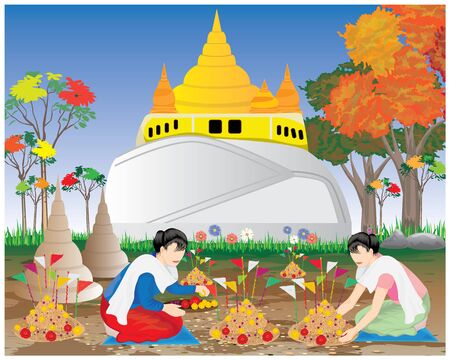Introduction to Ganesh Chaturthi and Its Cultural Significance
Ganesh Chaturthi, also known as Vinayaka Chaturthi, is one of the most celebrated festivals in Bharat, marking the auspicious birth of Lord Ganesha, the beloved elephant-headed deity. Revered as Vighnaharta (Remover of Obstacles) and Siddhivinayak (Bestower of Success), Lord Ganesha holds a special place in the hearts of millions across the country. This festival is not merely a religious event but an expression of deep-rooted cultural unity, faith, and devotion that transcends regional boundaries. From the grandeur of Mumbai’s public pandals to the intimate family pujas in Tamil Nadu, every region adds its unique flavour to Ganesh Utsav, reflecting the diversity and richness of Indian tradition. Across Maharashtra, Andhra Pradesh, Karnataka, Goa, Gujarat, and even Odisha and West Bengal, devotees come together to perform traditional Ganesh Puja Vidhi with great enthusiasm, seeking blessings for prosperity and wisdom. The rituals observed during this festival are steeped in symbolism and spiritual significance, reinforcing Lord Ganesha’s role as the harbinger of good fortune and new beginnings. As families prepare to invoke Bappa at their homes or community mandals, they align their celebrations with Shubh Muhurat timings based on their Rashi (zodiac sign), ensuring that every step is performed with utmost sanctity as per our age-old customs.
2. Understanding Ganesh Chaturthi Puja Vidhi
Ganesh Chaturthi, celebrated with immense devotion across India, is marked by a meticulous puja vidhi that reflects the spiritual richness of Bharatiya sanskriti. Each step in the Ganesh Puja is steeped in tradition, aiming to invoke the divine blessings of Lord Ganesha—the remover of obstacles and the harbinger of wisdom and prosperity.
Essential Samagri for Ganesh Puja
| Samagri (Item) | Significance |
|---|---|
| Mud/Clay Idol of Ganesha | Symbolizes earth and eco-friendly devotion |
| Kumkum & Haldi | For tilak and auspiciousness |
| Durva Grass & Modak | Lord Ganesha’s favourite offerings |
| Panchamrit (Milk, Curd, Honey, Sugar, Ghee) | For abhishekam (holy bath) |
| Sandalwood Paste & Flowers | For fragrance and purity during worship |
| Coconut & Betel Leaves/Nuts | Offerings representing surrender and devotion |
| Agarbatti & Deepam (Lamp) | To create a sacred ambience and dispel negativity |
| Aarti Thali & Bell | For performing the aarti ritual with devotion |
| Red Cloth or Vastra | Draped around the idol as a mark of respect |
| Puja Kalash with Mango Leaves | Invokes auspiciousness and prosperity |
Traditional Puja Vidhi Steps Followed in Indian Households
- Sthapana (Installation): The Ganpati idol is respectfully placed on a clean platform decorated with rangoli and flowers. A red cloth is spread under the murti, symbolizing shakti.
- Pran Pratishtha: The invocation mantra is chanted to welcome Lord Ganesha into the idol. Devotees meditate upon his presence using traditional Sanskrit shlokas.
- Panchamrit Abhishekam: The idol is bathed with Panchamrit followed by clean water, signifying purification.
- Aavahan & Puja: Lamp lighting, offering durva grass, modak, flowers, coconut, kumkum, haldi—each step rooted in deep symbolism and local parampara.
- Aarti: The whole family gathers to perform aarti with singing of “Sukhkarta Dukhharta” or other regional Ganpati aartis. The bell rings as camphor is lit in front of Bappa, infusing the environment with bhakti bhaav.
- Naivedya: The offering of sweets like modak or ladoo prepared at home; sharing prasad strengthens community bonds.
- Mantra Jaap & Prarthana: Sankata Nashanam Ganapati Stotram and other mantras are recited for removal of obstacles (vighna) and for samriddhi (prosperity).
- Visarjan: The immersion ritual marks the conclusion, performed as per family tradition—either on 1.5th day, 3rd day, 5th day or Anant Chaturdashi.
Significance of Family Participation in Puja Vidhi
The collective participation of all members—elders guiding the rituals, children reciting shlokas—ensures the passing down of our rich samskaras. This unity during Ganesh Chaturthi not only enhances spiritual well-being but also strengthens familial ties rooted in Indian cultural ethos.
Cultural Touchstones Across Bharat Varsha
While core rituals remain unchanged from Maharashtra to Tamil Nadu to Odisha, regional variations—such as usage of different prasad or unique aartis—reflect Bharat’s vibrant diversity. No matter where you celebrate—from bustling Mumbai chawls to serene Bengaluru apartments—Ganesh Chaturthi Puja Vidhi weaves every household into one beautiful tapestry of devotion and tradition.

3. Shubh Muhurat for Ganesh Chaturthi Puja as Per Rashi
Choosing the right Shubh Muhurat for Ganesh Chaturthi Puja is considered highly auspicious and spiritually uplifting, especially when aligned with one’s individual Rashi (zodiac sign). In Indian tradition, performing Lord Ganesha’s puja at the most favourable time ensures maximum blessings, removes obstacles (Vighna), and invites prosperity. Let us delve into how to select this auspicious timing by harmonising Panchang calculations with local customs and your personal Rashi.
Understanding the Role of Panchang
The Panchang—a traditional Hindu calendar—plays a crucial role in identifying the best Muhurat. It considers five elements: Tithi (lunar day), Vara (weekday), Nakshatra (constellation), Yoga, and Karana. For Ganesh Chaturthi, devotees generally look for Chaturthi Tithi during Shukla Paksha in the Bhadrapada month. However, fine-tuning this timing as per your own Rashi brings deeper spiritual resonance and cultural significance.
Muhurat Selection as per Individual Rashi
Each zodiac sign has its unique planetary influences and recommended timings for worship. For instance, Mesh (Aries) natives may benefit from morning hours when Mars is strong, while Vrishabha (Taurus) natives might find midday more harmonious. Consulting an experienced family Pandit or using trusted Panchang tools tailored to your region helps you identify these precise windows of divine energy specific to your Rashi.
Incorporating Local Customs
India’s cultural diversity means that customs for determining Shubh Muhurat can vary between regions—Maharashtra might favour early morning, while Tamil Nadu households may align with local sunrise timings. Respecting your community’s traditions alongside the guidance from Panchang and Rashi enhances the spiritual power of your Ganesh Chaturthi Puja, fostering a deeper connection with both Lord Ganesha and your ancestral roots.
4. Step-by-Step Guide to Performing Ganesh Chaturthi Puja
Ganesh Chaturthi is celebrated with immense devotion across India, and the puja vidhi may vary slightly as per local traditions and family customs. Here is a practical, easy-to-follow walkthrough for performing Ganesh Chaturthi Puja at home, incorporating contemporary eco-friendly practices and local flavors.
Preparation: Setting Up for Ganapati Bappa’s Arrival
- Clean the Puja Area: Start by thoroughly cleaning the space where the idol will be placed. Decorate with rangoli, flowers, and mango leaves for auspiciousness.
- Eco-Friendly Idol: Opt for a clay or natural material Ganesh idol to respect nature and uphold the principle of Vasudhaiva Kutumbakam (the world is one family).
- Puja Samagri: Prepare all items in advance—modaks, durva grass, red flowers, sandalwood paste, incense sticks, coconut, and betel leaves.
Puja Vidhi: Worshipping Lord Ganesha
- Sthapana (Installation): Place the Ganpati idol on an elevated platform facing east or north.
- Pran Pratishtha: Chant Vedic mantras to invoke Lord Ganesha into the idol with pure devotion.
- Shodashopachara Puja: Offer 16 traditional upacharas (ritualistic offerings) such as water for washing feet, hands, mouth; sandalwood paste; fresh flowers; dhoop; deepam; naivedya (offering food); and aarti.
Common Prasad Varieties Across India
| Region | Signature Prasad |
|---|---|
| Maharashtra | Ukadiche Modak, Puran Poli |
| Karnataka | Kadubu, Panchakajjaya |
| Tamil Nadu | Kozhukattai |
| Andhra Pradesh/Telangana | Kudumulu, Undrallu |
Eco-Friendly Visarjan (Immersion) Tips
- If possible, perform visarjan at home in a bucket or tub filled with clean water; later use the water for plants.
- Avoid chemical-based idols and synthetic decorations that harm rivers and lakes.
Local Customs & Rashi-Based Muhurat Considerations
Many families consult their family priest or Panchang to select an auspicious muhurat based on their Rashi (zodiac sign). Refer to your local temple or astrologer for personalized timings if you wish to align your puja with your horoscope. This blend of tradition and environmental awareness ensures both spiritual fulfillment and social responsibility during Ganesh Chaturthi.
5. Significance of Prasad and Offerings
The Spiritual Essence of Prasad
During Ganesh Chaturthi, the act of offering prasad holds deep spiritual significance. Prasad is not merely food—it is an embodiment of devotion, gratitude, and divine blessings. As devotees offer their prayers to Lord Ganesha, prasad becomes a sacred medium through which blessings are received and distributed among family, friends, and the community.
Popular Bhog Items: Modak, Ladoo & More
No Ganesh Chaturthi puja is complete without the preparation and offering of Lord Ganesha’s favorite sweets. The most iconic among them is modak, a sweet dumpling filled with jaggery and coconut, symbolizing happiness and wisdom. In Maharashtra, steamed modaks (ukadiche modak) are particularly popular, while fried versions are favored in South India. Alongside modaks, ladoo—made from besan or coconut—is another beloved offering believed to be close to Bappa’s heart. These sweets represent prosperity and joy, inviting auspiciousness into the devotee’s life.
Regional Variations in Offerings
Across India, the choice of prasad varies as per local tradition and regional tastes. In North India, devotees often prepare motichoor ladoo or boondi ladoo, while in West Bengal, sandesh or rasgulla may accompany the puja thali. In Tamil Nadu and Andhra Pradesh, offerings like kozhukattai (a variation of modak) and undrallu are prepared with rice flour and jaggery. This beautiful diversity in offerings reflects how each region imbues its unique culture into the celebration of Ganesh Chaturthi.
The Unifying Power of Prasad
No matter the region or recipe, prasad during Ganesh Chaturthi serves as a powerful unifier—breaking barriers of caste, creed, and language. Sharing prasad fosters a sense of togetherness and harmony within the community. It is also customary for families to exchange prasad with neighbours and relatives, strengthening social bonds and spreading Ganesha’s blessings far and wide.
Cultural Beliefs Associated with Offerings
Many households believe that preparing bhog with a pure heart multiplies its sanctity. It is common for elders to involve children in making modaks or ladoos, passing down recipes along with stories about Lord Ganesha’s love for these treats. The ritual reinforces values of devotion, patience, and unity within families—core aspects of Indian culture that are celebrated throughout Ganesh Chaturthi.
6. Celebrating Ganesh Chaturthi: Contemporary Practices
Ganesh Chaturthi has always been a festival rooted in deep spiritual significance and vibrant cultural expression across India. In modern times, while the core Puja Vidhi and adherence to Shubh Muhurat as per Rashi remain central, the ways in which communities celebrate have evolved, reflecting both urban lifestyles and growing environmental consciousness.
Visarjan Processions with a Modern Touch
The tradition of Ganpati Visarjan—the immersion of Lord Ganeshas idol in water bodies—remains an emotional and spiritual climax to the festivities. Today, these processions are marked by both grandeur and responsibility. Many cities have introduced eco-friendly processions where devotees are encouraged to use clay idols and natural colours, reducing the environmental footprint. Local authorities often collaborate with organisers for smooth traffic management and safety, ensuring that traditions continue without disrupting daily life.
The Rise of Community Pandals
Community or Sarvajanik Ganesh Pandals have become iconic representations of collective devotion, creativity, and social unity. These pandals now feature themes ranging from mythological stories to contemporary issues like digital India, women empowerment, and environmental conservation. Organising committees ensure that Puja Vidhi is performed according to individual Rashi, offering personalised rituals for devotees who seek blessings based on their astrological sign. This blend of faith and inclusivity helps bring together people from all walks of life.
Youth Participation & Eco-Awareness
A significant shift in recent years is the active role played by Indian youth in shaping the festival’s future. Young volunteers spearhead campaigns promoting biodegradable idols, ban on plastic decorations, and water conservation during Visarjan. Social media platforms buzz with creative initiatives like “Green Ganesh” contests and digital awareness drives, making the message of eco-friendly celebration accessible even in remote corners of the country.
Cultural Continuity with Contemporary Relevance
While modern practices adapt to changing times, they do not dilute the essence of Ganesh Chaturthi. Instead, they add new layers of meaning—honouring age-old traditions like observing auspicious timings (Shubh Muhurat) as per Rashi, while fostering communal harmony and sustainability. In this way, Ganesh Chaturthi continues to unite Bharatvasis in joy and reverence, celebrating Lord Ganesha’s arrival with devotion and progressive spirit.


